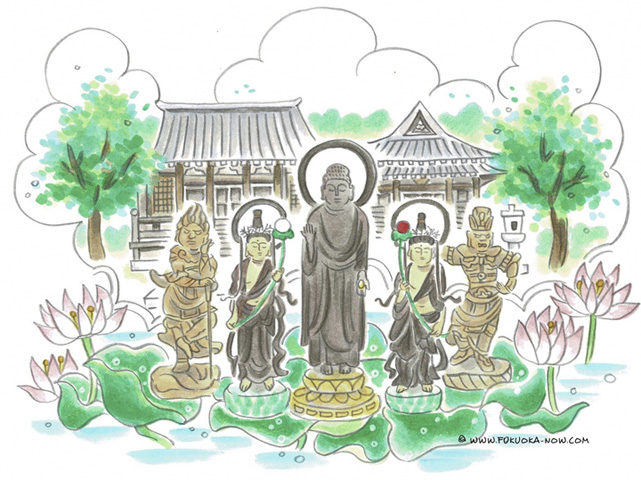Hakata Culture vol.184
Tokoin Temple: Once a Treasure Trove of Cultural Assets

Tokoin Temple is said to have been built in 806 by Saicho (aka Dengyo Daishi). Originally a Tendai temple where Saicho preached, it became a Zen temple for a time before becoming a branch temple of Jotenji Temple, which is located near Hakata Station. In 1647, Tadayuki Kuroda, the second lord of the Fukuoka Domain, converted the temple to the Shingon sect of Buddhism, and that is when it was given the name Tokoin Temple (aka Yakuo Mitsuji). The commoners of the time were fervent believers and referred to the temple colloquially as Katakasu no Yakuo-sama, and even today, Tokomachi still exists as a place name in Fukuoka.
Tokoin Temple was a repository for numerous cultural assets. In addition to the standing statue of Yakushi Nyorai, the principal deity enshrined at the temple, Tokoin had 25 Buddhist statues designated by the national government as important cultural properties. There were also 15 paintings designated by Fukuoka Prefecture as cultural assets. As a religious entity, Tokoin was dissolved about 40 years ago, and these cultural properties were donated to Fukuoka City along with the temple grounds. The statues and paintings are now on display or in storage at the Fukuoka City Art Museum.
The items on display can be found in the Buddhist Art from Tokoin Temple Room, which is part of the museum’s permanent collection. These include the statue of Yakushi Nyorai, who is said to cure all kinds of illnesses and carries a pot of medicine in his left hand, and statues of the supporting bodhisattvas, Nikko Bosatsu and Gekko Bosatsu, who are responsible for assisting Yakushi Nyorai. There are also statues of the Twelve Divine Generals, who protect the believers of Yakushi Nyorai, as well as statues of Kongo Rikishi, the guardian deities that are enshrined at temple gates. The states are all well-preserved and serve as excellent representations of their original state.
The site where Tokoin was located, which has been designated as a historical site by the city, is beautifully maintained and open to the public. Today, the main hall, Seitendo Hall, Niomon Gate and a storehouse still remain, and visitors can enjoy strolling through the quiet temple precincts. The bronze statue on the temple grounds is the nun Kiyoto Taijun, the 19th and last abbess of Tokoin. She is the person who decided to donate everything to Fukuoka City to ensure that the precious and important cultural assets will be preserved for future generations.
文化財の宝庫だった東光院
東光院は806年に最澄(伝教大師)によって建立されたと伝わる寺院です。もともとは最澄が教えを説く天台宗の寺院でしたが、一時期は禅宗となって博多駅前にある承天寺の末寺となりました。さらに1647年に福岡2代藩主・黒田忠之が真言宗に改め、薬王密寺東光院となります。庶民の信仰も厚く、「堅粕の薬王さま」として親しまれ、市内には東光町という地名も残っています。
この東光院は文化財の宝庫でした。本尊である薬師如来立像のほか、国の重要文化財に指定された仏像を25体も所蔵していました。さらに、福岡県の指定文化財になっている絵画15点もありました。宗教法人としての東光院は約40年前に解散してしまったのですが、これらの文化財は境内地とともに福岡市に寄贈されました。仏像や絵画は福岡市美術館に収蔵・展示されています。
展示されているのは福岡市美術館の常設展示室内にある「東光院仏教美術室」。左手に持つ薬壺であらゆる病を治してくれるという本尊の薬師如来。その薬師如来を助ける役目をする脇侍の日光菩薩と月光菩薩。薬師如来を信じる人々を守る十二神将や、寺を守るために門に安置される金剛力士像もあります。仏像はいずれも保存状態が良く、作られた当初の姿をよく伝えています。
東光院があった場所は市の史跡に指定され、きれいに整備されて一般公開されています。現在でも本堂、聖天堂、仁王門、収蔵庫などが残っており、静かな境内を散策することができます。境内にあるブロンズ像は、東光院第19世で最後の住職となった清藤泰順(きよとうたいじゅん)尼です。貴重で大切な文化財を後世に残すため、すべてを福岡市に寄贈することを決断した人物です。

